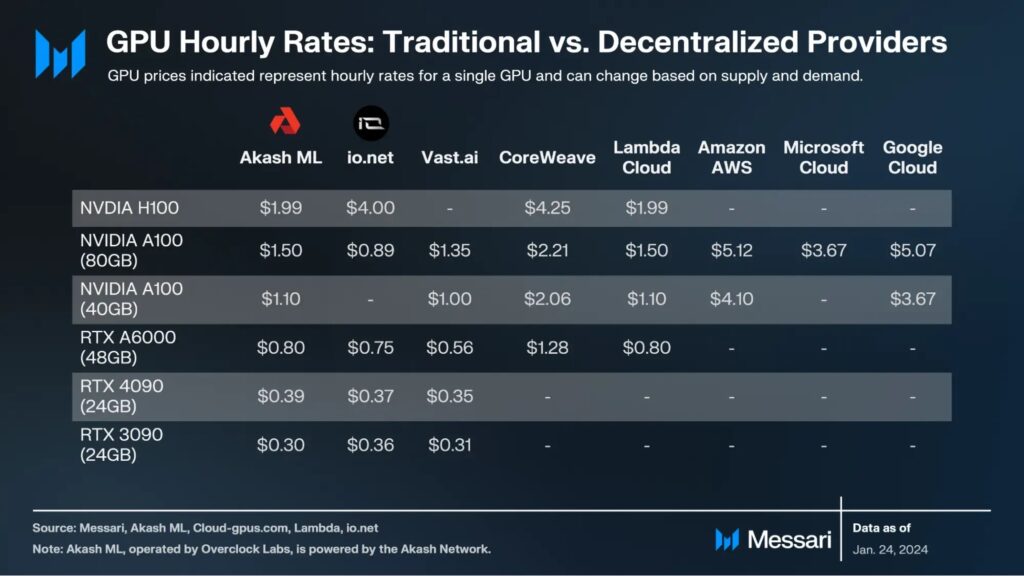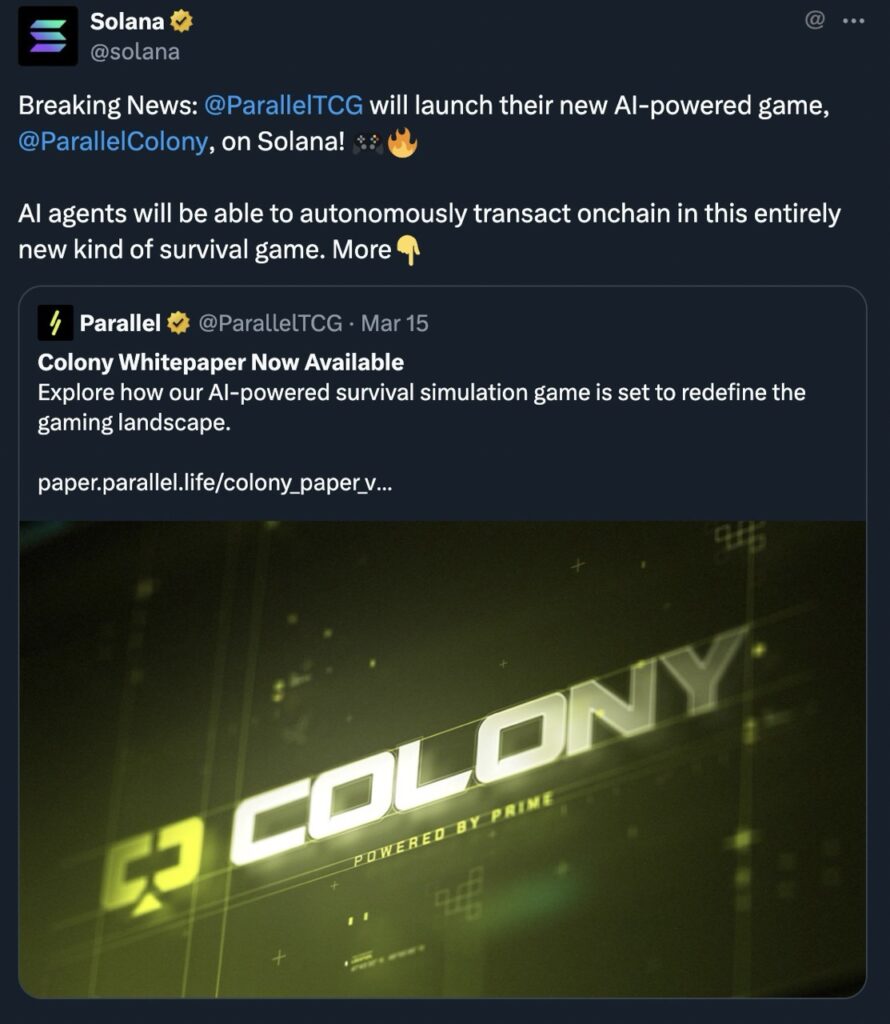The AI or Artificial Intelligence sector is one of the sectors that has suddenly broken the mainstream of the technology industry. Investors, businesses, technology companies, and ordinary people are starting to realize the potential of the AI sector. We will explore the potential of AI and crypto integration and a look at some of the existing crypto AI projects.
Article Summary
- 📱 Integration of AI and Crypto Offers Decentralized Solutions: Emerging as a response to the dominance of large tech companies, the integration of AI and crypto brings the potential for more open and decentralized AI development.
- 💻 Importance of Computational Resources and Data: Two key elements in AI development, computing, and data, are coming into focus, with crypto projects offering a more affordable and efficient alternative to traditional solutions from large corporations.
- 🤖 AI Agents and Decentralized AI Development as Potential Areas: Experiments with AI Agents and AI development platforms such as Bittensor highlight the possibility of new and innovative applications that could provide real benefits to users and developers.
- 📡 Unexplored Future Potential: Although still in its early stages with many projects yet to launch products, the integration between AI and crypto has great potential to change how AI is developed and applied, promising a new era of decentralized innovation and applications.
AI and Crypto Integration

The integration of AI and crypto is something very new. The AI category has only recently appeared on popular crypto sites such as CoinMarketCap and CoinGecko. On CoinGecko, the market capitalization of the AI sector is only $17 billion. Bittensor is the only decentralized AI project and the largest. Although we are still in the early stages, dozens of projects have already begun to develop AI and crypto integration.
The integration of AI and crypto arises from concerns about the centralization of AI in the hands of companies like OpenAI and Google. These companies have control because they own the technology and massive computing resources. People like Casey Caruso think AI development should be open-source. The open-source and decentralized nature of Blockchain and crypto fits right in.
Computation and Data: Two Important Resources for AI Development
Two important elements in AI development are data and computation. Both are essential in all stages, including training, optimizing, and deploying AI. The need for large amounts of computing power and data is huge for developing AI. Not to mention, computing resources are needed when the model has to perform inference (answering instructions from users and providing solutions).
OpenAI’s CEO, Sam Altman, even said the total cost to train a model like ChatGPT is more than $100 million. Business Insider even explains that ChatGPT costs $700 thousand every day. Moreover, these costs will continue to increase as AI models become more sophisticated.
The most common AI model today is the LLM or Large Language Model such as ChatGPT and Bard.
With such high costs, AI development is only feasible for teams with access to computing resources and big data such as Microsoft, Google, and the like. Therefore, the crypto industry presents an alternative to this situation.
What are the Uses of Crypto for the AI Sector?
- Decentralized physical network: The DePin sector provides alternative computing resources to companies developing AI. The fees offered by these protocols are also much cheaper.
- Crypto-based Incentives: The crypto industry also provides incentives using crypto to encourage AI development from teams without large funding. These incentives can also be provided at all stages of AI development, including model training.
- Decentralized Verification Network: Blockchain provides a permanent, transparent, and independent verification system. Blockchain has the potential to be used to verify data generated from AI, test the veracity of the data, and distinguish original data from AI data.
Sectors of AI and Crypto Integration
1. Decentralized Computing

The decentralized computing sector is today’s biggest example of AI and crypto integration. The two leading projects in this sector are Akash and Render whose market capitalization has already reached $1 billion. Beyond these two, there are Nosana, Gensyn, IO.net, and Ritual.
The decentralized computing sector is divided into two based on its function:
- General computation: Projects that provide general computing resources for various needs. In AI, the computational needs in this category are needed to perform inference for general LLM models such as ChatGPT. Some of the projects in this category are Render, Akash, and Nosana.
- ML (Machine Learning) specific computing: Used specifically for training AI models, model refinement, and inference. This type of computing requires advanced GPU hardware, above the average consumer device. Projects in this category are Bittensor, Akash, IO.net, and Gensyn.
The decentralized computing sector is one of the AI X crypto integration sectors with clear uses and target markets. Computing resources are a commodity whose demand will continue to increase as the AI industry grows.
In addition, the computing prices offered by crypto projects like AKASH are far below those charged by Amazon, Microsoft, and Google. Decentralized services like AKASH also cannot be censored, making it suitable for teams developing experimental AI models.
2. AI Agents

AI Agents is a term for experiments that place AI as a user capable of receiving, interpreting, and executing instructions using AI models. These AI agents are capable of performing operations on behalf of users or programs with a predefined level of autonomy. Furthermore, some of the uses being explored are trading accounts based on AI models and AI as a player in blockchain-based games.
Singularity, Fetch.AI, and Autonolas are the three largest AI agent projects today. They provide a marketplace for AI agents, a framework to build them, and a platform to use them.
Beyond the infrastructure, several applications are experimenting with Agents. AI Arena is a blockchain-based game that utilizes AI players built by players. These AI players will then battle other AI players. In addition, users can continuously improve and develop the AI player’s abilities.
Meanwhile, Parallel Colony is a game specifically to facilitate AI players called “Avatars” that users can purchase in the form of NFTs. Colony is a breakthrough implementation of AI in games as Avatars are autonomous AI agents with unique parameters. Avatars will perform tasks such as gathering resources and transacting within the game.
AI Agents are one of the AI and crypto integrations with the most potential uses. However, to date, no project in this sector has been able to capture the attention of the market or create a product with proper market fit.
3. Decentralized AI Development

The development of decentralized AI is one of the most talked about topics. Many hope that the crypto industry can become a home for new AI models that are decentralized. Bittensor (TAO) is one such decentralized AI project that promises an AI development ecosystem based on decentralization and cryptocurrency incentives.
Unlike previously discussed projects, Bittensor is a full-stack AI platform for for all stages of AI development. Bittensor provides a unified platform for AI development, from data collection, and model training, to computational resources for inference.
Bittensor consists of dozens of Subnets (SN) that function similarly to application blockchain in the Cosmos ecosystem. Currently, there are 32 Subnets in Bittensor, each performing a unique function. For example, SN 3 provides data scraping instruments while SN 6 trains LLM model. This ecosystem of Subnets is what allows Bittensor to become a unified AI development ecosystem as each SN complements the other’s functions.
The Future of AI and Crypto

AI category on CoinGecko.
The AI and crypto integration narrative has been one of the most talked about in recent months. This is not without reason as the AI and crypto integration sector has huge unexplored potential.
The potential for AI and crypto integration is exciting, especially with many projects still in development and yet to launch their products. Ritual and Modulus Labs are examples of two projects looking to integrate AI into smart contracts technology. Both enable trustless interactions between the blockchain ecosystem and AI models, opening up many new potential uses such as creating AI-generated data verification systems.
Fundamentally, we can’t yet gauge how big the potential of AI and crypto integration is. As of now, the decentralized computing sector is the only one that has found its market. We still need to see whether projects like Bittensor or the AI Agents sector can successfully attract users or not.
Conclusion
The integration between AI (Artificial Intelligence) and crypto marks a new chapter in the tech industry, which emerged as a response to the dominance of large companies like OpenAI and Google in AI development. This sector includes projects offering decentralized solutions to computational challenges and big data management, two important resources in AI development.
The decentralized computing sector, AI Agents, and decentralized AI development are some of the key areas, that offer alternatives for cheaper computing resources and a more open development model. Although still in its infancy with many projects yet to launch their products, the integration of AI and crypto has great potential to change the way AI is developed and implemented in the future.
How to Buy Crypto on the Pintu App
You can start investing in cryptocurrencies by buying them on the Pintu app. Here is how to buy crypto on Pintu:
- Create a Pintu account and follow the process of verifying your identity to start trading.
- On the homepage, click the deposit button and top up the Pintu balance using your preferred payment method.
- Go to the market page and look for your favorite crypto.
- Click buy and fill in the amount you want.
- Now you are a crypto investor!
In addition, the Pintu application is compatible with various popular digital wallets such as Metamask to facilitate your transactions. Go and download the Pintu cryptocurrency app on the Play Store and App Store! Pintu is regulated and supervised by Bappebti and Kominfo.
You can also learn crypto through the various Pintu Academy articles updated every week! All Pintu Academy articles are for educational purposes, not financial advice.
References
- Lucas Tcheyan, “Understanding the Intersection of Crypto and AI”, Galaxy Research, accessed on 12 March 2024.
- Casey Caruso, “Decentralized AI”, accessed on 12 March 2024.
- @0x___Brick, “Recently published a comprehensive overview of the Crypto x AI space. There seems to be some confusion regarding the vertical (AI on the blockchain type beat)”, Twitter, accessed on 13 March 2024.
- Vitalik Butern, “The promise and challenges of crypto + AI applications”, accessed on 14 March 2024.
- Sami Kassab, Seth Bloomber, dan Dustin Teander, “ETH Denver 2024 Analyst Takeaways”, Messari, accessed on 14 March 2024.
- David Attermann, “Exploring the Convergence of AI and Web3: Opportunities and Challenges in the New Tech Landscape”, CoinDesk, accessed on 15 March 2024.
- Sami Kassab, “Discovering Taoism: A Journey into Bittensor”, Messari, accessed on 15 March 2024.
